Choosing which crop to grow Besides the various grain crops like maize and pearl millet, there are several groups of vegetable crops to choose from.
Farmers can consider the following:
Leafy vegetables: Plants with edible leaves, for example, cabbage, spinach, and Swiss chard.
Fruiting vegetables: Plants with edible fruit, for example, tomatoes, peppers, and melons.
Root vegetables: Plants that store food in their own roots or in their tubers underground, for example, carrots, beetroot, and sweet potatoes.
Legumes: Plants that produce pods with edible seeds, for example, cowpeas and green beans.
Bulb vegetables: Plants that store food in swollen leaves at the base of their stem, for example, onions.
It is advisable to grow crops from each group. It provides the farmer with a variety of products so that he will have something to eat and sell throughout the year.
Selection of seeds
Improved cultivars for most crops are widely available in Namibia. Most of the more expensive seeds on the market are hybrids with the following distinctive advantages above home-produced, open-pollinated seeds.
Hybrids usually: germinate better; produce a higher yield; have key resistance or tolerance to diseases and some insects; and possess other desirable characteristics such as better size, shape, colour, heat tolerance and resistance to injury.
Seed companies are continuously improving varieties. Therefore, the best variety to choose will change as time passes. Furthermore, companies generally do not guarantee the germination percentage of low-cost varieties.
It should be recognised that using the best seeds available is the wisest decision. Yields will, on average, be higher and costs of pest management should be lower. A higher marketable or consumable yield will make the extra expense of good seeds pay for itself.
Seedbed preparation and planting of crops
Seedbed preparation
A seedbed is a special area where the soil is carefully prepared to help the germination of seeds. The process of seedbed preparation is called tillage. Young plants grow best in soil that has been broken up into small crumbs; such soil is described as having a fine tilth. In a seedbed, it is possible to carefully control the depth of and distance between seeds.
A seedbed should be deep, even and firm. The objectives of tillage are:
- granular structure is desirable to allow rapid infiltration and good retention of rainfall, whereas finer particles are considered advantageous in the vicinity of seeds;
- to control weeds;
- to incorporate plant residues into the soil to create humus and increase nutrient levels;
- to minimise soil erosion by following practices like contour tillage and proper placement of plant residues;
- to establish specific surface configurations for planting, irrigation, drainage and harvesting operations;
- to incorporate and mix fertilisers and pesticides into the soil.
Tillage operations are classified as primary and secondary tillage. Implements used for this purpose can be divided into primary and secondary implements. Primary implements are basic implements used to loosen the soil and sometimes invert it to improve the structure and counter compaction.
These implements include mouldboard ploughs, disc ploughs, chisel ploughs and rippers. Secondary implements include cultivators, discs, and harrows, and are used for the final seedbed preparation, weed control, and breaking of surface crusts.
In recent years there has been an increasing interest in minimum-tillage systems as a means of reducing rowcrop production costs and minimising soil compaction caused by repeated heavy tractors driving on the field. In some minimum-tillage systems, till-andplant combination units follow ploughing, chiselling, or other primary tillage, with narrow strips receiving shallow secondary tillage just ahead of the planter.
Other types of combination units perform zone or strip tillage just ahead of the planters in untilled soil or in soil that was ploughed during the previous fall. Several arrangements of combination units that perform minimum-tillage and planting operations are commercially available.
Primary tillage implements
Mouldboard plough
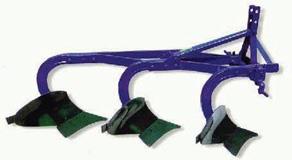
Mouldboard plough
This implement is used to turn soil up to 300 mm deep and is particularly useful in heavier soils. The mouldboard plough is not recommended for sandy soil, because the already poor soil structure may be destroyed, which again promotes wind erosion.
Chisel plough
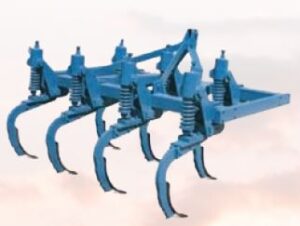
Chisel plough
Chisel ploughs are used to loosen the soil to a limited depth of 250 mm. It is
mainly recommended for relatively dry and sandy soils.
Disc plough
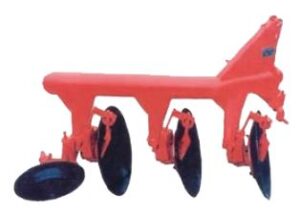
Disc plough
The disc plough has a slicing action with the main advantage that better water penetration is obtained. It is also very effective on land with large amounts of plant residues, because it promotes rapid breakdown of soil structure. This implement is therefore useful for hard, dry soils but not recommended for sandy soils.
Ripper plough
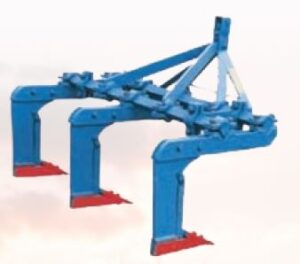
Ripper plough
Rippers are used when deep cultivation of up to 400 mm is necessary and turning of the soil is undesirable. if soils are tilled annually to the same depth, a plough-sole develops. This compacted layer prevents infiltration and root development. To ensure better drainage and utilisation of water, it is essential to break this layer regularly.
Secondary tillage implements
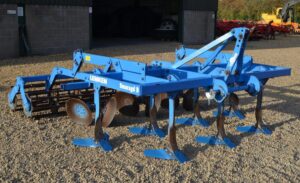
Secondary tillage implements include a variety of implements like cultivators and harrows. Harrows are mainly used to level the seedbed and for breaking larger surface crusts. Cultivators are mainly used to control young weeds but are also used for breaking surface crusts. The tilling depth is seldom more than 100 mm. These implements are only effective for moist soils and are often used for seedbed preparation.
Sowing of crops directly in the field
Crop planting operations may involve placing seeds or tubers (such as potatoes) in the soil at a predetermined depth. This can be done by hand or with machines. With appropriate planting equipment, seeds may be distributed according to any of the following methods or patterns:
Planting may be done on the flat surface of a field, in furrows or in beds, as illustrated in Figure 1. Furrow planting is widely practised under semi-arid conditions for row crops such as maize and mahangu. This method places the seed in moist soil and protects the young plants from wind and soil being blown around. Bed planting is often practised in high-rainfall areas to improve surface drainage. Flat planting generally predominates where natural moisture conditions are favourable.
A variation of bed planting provides a flat plateau, perhaps 7,5 cm high and 25 cm wide in the bottom of the furrow. Bed planting is common for certain types of row crops in irrigated areas. With closely spaced row crops such as sugar beet, lettuce, and other vegetables, two or more rows are sometimes planted close together in a single bed, thereby leaving more width in the spaces between beds for the operation of equipment.
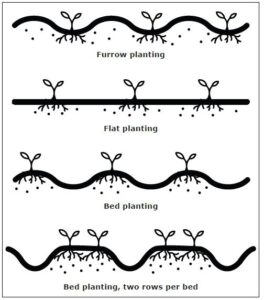
Crop bed planting.
The information in this article is credited to the Namibia Agricultural Union and Namibia National Farmers Union who published the Crop Production Manual in 2008.










Helpful insights.
Thank you